An Open Letter to Writing Instructors from a Motivated Student
Your content has been saved!
Go to My Saved Content.I am a 24-year-old college student who sometimes just wants a grade, but most of the time wants thorough, purposeful and encouraging feedback that helps me strengthen my writing skills. As a Secondary English Education major at East Carolina University, I have been exposed to various methods of teaching literature and writing, and have archived all of my past papers in binders and file cabinets for future reference. My friends think I am in need of an intervention for being over-organized, but I think that being more aware of how my instructors teach and assess students will improve my writing and provide me the opportunity to identify assessment methods that I can make my own in when I start teaching composition.
What follows is a personal tour of the various response/assessment methods I have encountered, with special emphasis on those that have positively impacted me as a student and writer.
Rubrics
Many of my high school and college instructors used rubrics to grade my work, and they have reminded me to include particular details in my writing. But too often, I only received scores without further feedback. I wish my teachers had annotated the rubric. Without commentary, it was difficult to decipher where I need to improve, not to mention how my grade was decided.
Portfolios
In many courses, I felt like an overworked employee at an essay factory, producing ten to twelve mediocre and forgettable papers -- ones that teachers accepted as final drafts that were, in actuality, first drafts. I wish those courses had given me a chance to react to instructor feedback with revised and successful second drafts. In contrast, courses utilizing portfolio assignments encouraged me to put forth more conscientious efforts to improve, letting me show how and when I strengthened my writing skills. I wish that all of my instructors had challenged me to produce portfolios with five or six mind-blowing papers instead of valuing quantity over quality.
Word Processors
To be honest, some instructors have chicken-scratch handwriting. Usually, they are available for translation after class, but I wish I could have been able to read their handwriting in the first place. If you suspect or have been told by disgruntled students that your handwriting is indecipherable (Fig. 1), perhaps you could use a word processor to respond to student work. And because we notice your spelling errors, remember to use a spell checker.
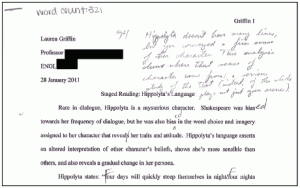
Instructors who used word processors usually gave me more than just a sentence or two of comments; they offered meaty and purposeful feedback. I appreciate instructors who demonstrate that they care about my growth as a writer by giving me detailed and constructive advice (Fig. 2). As a consequence, I have become more aware of my writing process.
Most of the instructors who typed out their feedback included three points.
- Kudos for what they thought I did well
- Notes about what they thought my most frequent errors were, along with advice on how I could correct those errors
- Resources (links) to help expand my ideas and skills
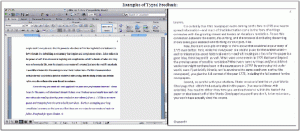
Some instructors commented directly on hard copies of my writing and included typed feedback on a separate page. Though they didn't fully embrace technology's advantages, I liked how they made handwritten annotations for lower order concerns (misused punctuation, grammar, spelling) and used their typed feedback to address higher order concerns (unclear thesis or focus, disorganization, minimal utilization of research or examples).
I did have an instructor who included handwritten and typed feedback (Fig 3). This instructor would write out "(A)," "(B)," "(C)," etc. in the margins of my hard copies, and then in typed feedback at the bottom of the essay explain what concerns "(A)," "(B)," "(C)," etc. were addressing. Flipping through the pages and matching up the annotations with the feedback created confusion and paper cuts!
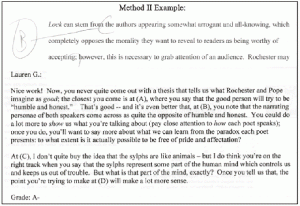
Several instructors only accepted and returned papers via email or learning management systems like Blackboard; this was advantageous because I didn't have to frantically search for an available computer on campus during my precious minutes before class to print out a hard copy, not to mention that virtual transactions were environmentally friendly and faster! These instructors often used Microsoft Word's "Comment" or "Track Changes" features to identify, highlight, and comment on concerns (Fig. 4). To me, this method is the most ideal because the colorful highlights showed me exactly where to look for what I should revise, and the neighboring comment boxes immediately provided advice on how to revise.
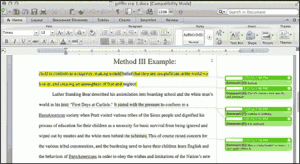
I recently had an instructor who used Google Docs to insert comments (Fig. 5). Each time he did this, I received an email notifying me, which enabled me to watch his assessment process live. It felt as if I were spying on him, but more importantly, it motivated me to edit and revise immediately for my second draft. And that level of interactivity made the writing process entertaining and fun!
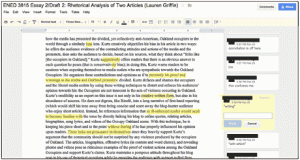
Writing instructors, you should know that I don't want just grades; I want to be motivated to strengthen my skills. I am inspired to improve when you address specific issues in my prose. Using technology-enhanced commentary shows me that you care enough to use a communication channel that my generation prefers. So thank you, writing teachers who made the effort to guide me in the writing process by clearly explaining the whys and hows.